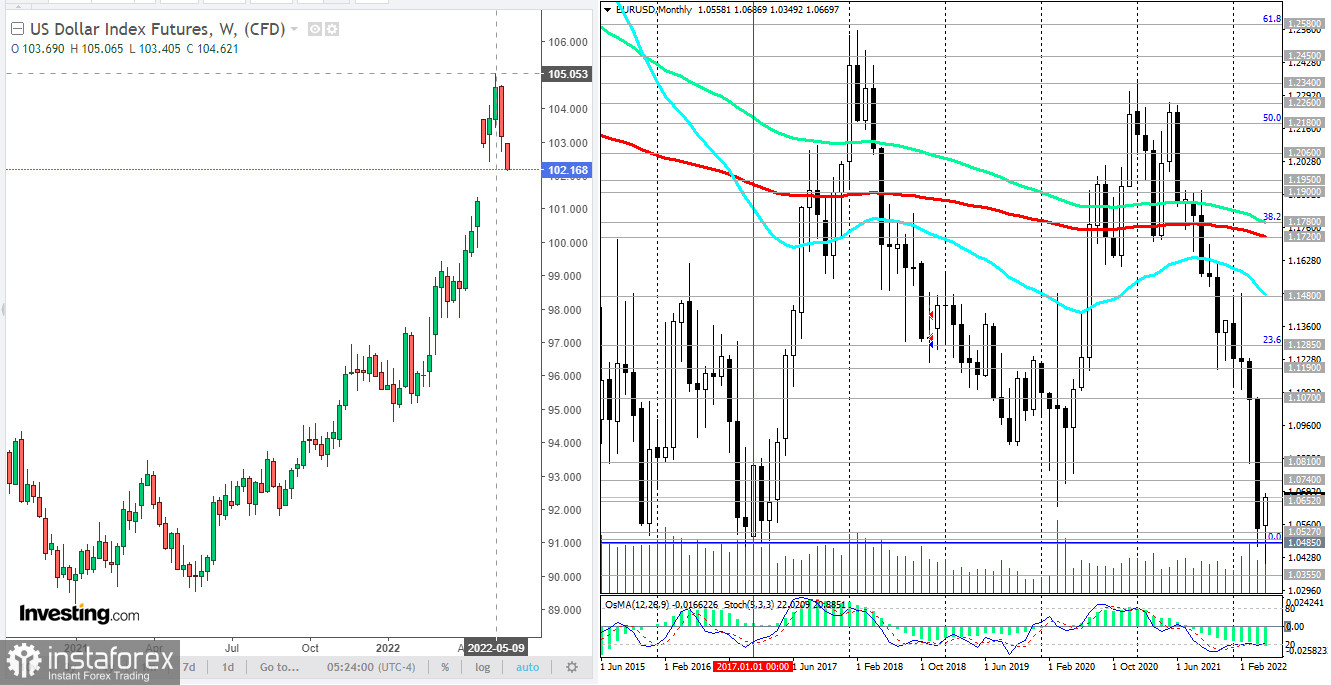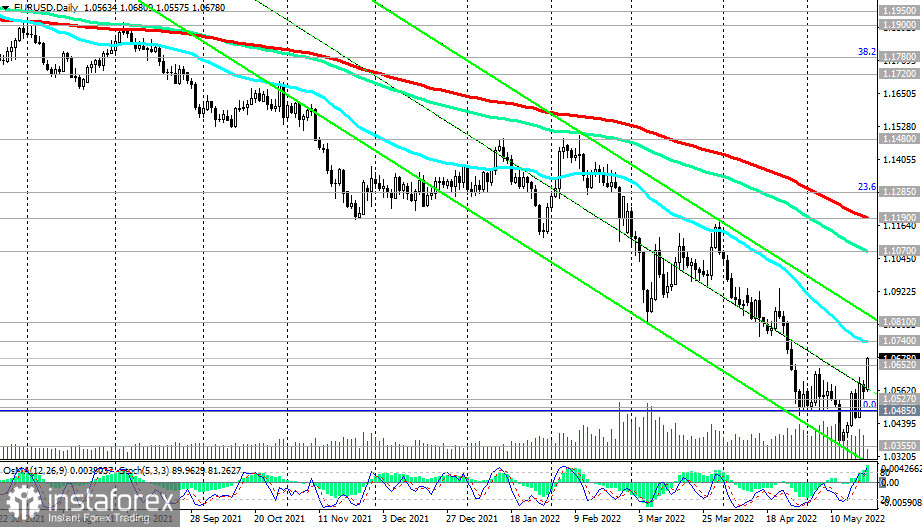Having completed the past week with a decent decline (by 0.88%), the dollar index (DXY) begins a new active decline. At the time of writing this article, futures for the DXY index are near 102.17, 289 points below the local top (since January 2003) of 105.06, reached in the first ten days of May.

Against the general background of the weakening dollar, the EUR/USD pair stands out, which is trading, as of this writing, near the 1.0685 mark, 122 points above the opening price of today's trading day. The intraday volatility of the EUR/USD pair fluctuates in different periods of the year. On average, it ranges from 50 to 120 points, but can exceed 300 points during periods of publication of important news of a political or economic nature. Thus, EUR/USD rose to the maximum value of intraday volatility under normal conditions.
As ECB President Christine Lagarde said today, "we [ECB] are likely to be in a position to exit negative interest rates by the end of the third quarter." She also expects the Asset Purchase Program (APP) to end very early in the third quarter, and "if we [the ECB] see inflation stabilising at 2% over the medium term, a progressive further normalisation of interest rates towards the neutral rate will be appropriate. The ECB will take all necessary steps for this."
According to Lagarde, the ECB may raise its key interest rate in July (for the first time in 11 years) to reduce the risks of record high inflation and ease growing concerns about euro weakness. At the moment, the key rate of the ECB is -0.5%.
Eurozone inflation has accelerated in recent months rather than eased as expected. In April, annual inflation in the euro area was 7.4%. "We have one important policy benchmark, which is to keep inflation at 2% over the medium term," Lagarde also said.
The euro strengthened sharply on the back of her statements, also receiving short-term support from the publication (at 08:00 GMT) of a report by the German research institute IFO, according to which the level of business confidence in Germany increased in May. Thus, the German business sentiment index rose to 93.0 in May (against the forecast of 91.2 and 91.9 in April).
The current conditions index rose to 99.5 in May from 97.3 in April, while the expectations index rose to 86.9 from 86.8 in the previous month. "There are currently no observable signs of a recession," Ifo President Clemens Fuest said, adding that "the German economy has proven itself resilient in the face of inflation concerns, material bottlenecks, and the war in Ukraine."
The German economy is the locomotive of the entire European economy, and the improvement of the business climate in it and the improvement of its indicators have a beneficial effect on the entire European economy and the position of the euro.
The EUR/USD pair continues to rise today, also ending in positive territory last week (against the weakening dollar), while market participants continue to assess how actively the Federal Reserve will raise interest rates to tame rising inflation.
During his speech at the Wall Street Journal's Future of Everything Festival on Tuesday, Fed Chairman Jerome Powell said that the Fed "has both the tools and the resolve to get inflation under control." He confirmed that the Fed leadership intends to raise interest rates by 0.50% at the next two meetings. "What we need to see is inflation coming down in a clear and convincing way, and we're going to keep pushing until we see that," Powell said. However, avoiding a recession in the US will not be easy, and restoring price stability "may be painful," in his opinion.
The dollar weakened amid Powell's statements. Obviously, market participants expected tougher statements from him, while the expected interest rate hike by 0.50% at the next two meetings, according to Powell himself, has already been priced in.
Managers of US companies also worry that an excessive tightening of financial conditions could affect economic growth as a whole.
Nevertheless, economists still expect the dollar to strengthen again, and one of the main reasons for this is the Fed's monetary policy, the most stringent among the world's largest central banks.
From a technical point of view, there will be a rebound from the current levels, and the EUR/USD pair will resume its decline. The maximum level that the price can "reach" is, possibly, the mark of 1.0740.

It is also possible that this level can be reached within the next two and a half days, until the publication of the minutes of the May FOMC meeting on Wednesday (at 18:00 GMT). Market volatility will increase, and the dollar may sharply strengthen if the text of the minutes contains new information regarding the Fed's plans for monetary policy. The harsh rhetoric of the Fed leaders will push the dollar to further growth. Conversely, the soft tone of the protocols will reflect negatively on the US dollar.
 Tiếng Việt
Tiếng Việt 
 Русский
Русский English
English Bahasa Indonesia
Bahasa Indonesia Bahasa Malay
Bahasa Malay ไทย
ไทย Español
Español Deutsch
Deutsch Български
Български Français
Français 中文
中文 বাংলা
বাংলা हिन्दी
हिन्दी Čeština
Čeština Українська
Українська Română
Română

